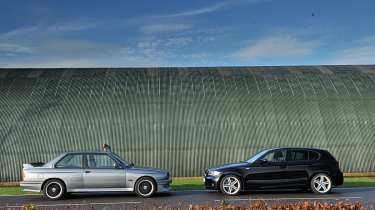Evolutions: BMW E30 M3 v 123d
The original M3 is our favourite M-car, but it’s now 25 years old and, on paper, a 123d is every bit as fast. We find out the truth...
One of these cars is an icon. It’s a car born from the need for homologation and has an enviable motorsport pedigree. The other is a five-door diesel hatchback, capable of 60mpg in the right circumstances. But banish those thoughts from your mind, just for a moment. Instead, look at the bald statistics in front of you. In terms of the facts most commonly quoted in public houses across the land – namely power, 0-60mph and top speed – these two cars could hardly be better matched. They’re even a similar size, with less than 100mm between the two in any given dimension.
There’s always been the nagging thought that, magical though the original M3 is, it’s actually a bit slow. So here’s the scenario: You’re in a 123d, and as you flash past a junction an E30 M3 pulls out behind you. You look in the rear-view mirror and see the unmistakable phizog of John Barker behind those four round lights. The game’s afoot. Ahead lies a cross-country strop taking in a variety of B- and A-roads, with all the challenges that involves. Do you really stand a chance of keeping ahead? Or could a superior torque figure and a 20-year advance in chassis technology even shrink the old M3 in your mirrors? Time to find out.
Pootling through a village, the M3 is right on the tail of the 123d. We’re religiously observing the 30mph limit, but up ahead lies the national speed limit. We know what’s coming…
At this point if you asked me to predict a winner in the acceleration wars, it would be the 123d. Even though this is a slightly later Ravaglia special-edition M3 with 212bhp, and although the 123d in its outgoing five-door form has a 255kg lardier kerb weight, the little diesel has a massive torque advantage, its turbocharged four-pot churning out 295lb ft compared with the E30’s 170lb ft. Look at the in-gear figures (see table) and there’s still nothing to suggest that the 123d won’t pull out a healthy few car- lengths as the throttles are opened.
Both of us accelerate at the same time – and contrary to expectations the distance between the two cars stays exactly the same down the next straight. Over the next half-an-hour we swap drivers’ seats and repeat the process out of every 30 or 40 limit. Sometimes the 123d gains a few initial yards, but other times the M3 does the same. Largely the two BMWs couldn’t be more locked together unless they were bump drafting.
Despite first impressions, the reason for this parity can actually be found in the in-gear figures that we recorded on the old runway at the Bedford Autodrome. Essentially, the trick is that the M3 will be in second gear while the 123d (which has shorter gearing than its 120d sibling) is in third. Even if the 123d is primed in second gear to get the jump on the E30, it will need a time-sapping change-up to third a good 20mph before the M3 has soared its way to 7000rpm and 60mph.
This is all backed up by two additional tests we performed with the timing gear attached. In a 30-90mph roll-on acceleration test, the M3 covered the ground two-tenths of a second quicker. Even more astonishingly, in the 45-80mph test – similar to our old TED (Time Exposed to Danger) or overtaking-a-lorry test – the 123d takes 8.75sec but the M3 just 6.67.
Something that doesn’t show up in the figures is a slight hesitation in the 123d’s response to a floored throttle. This could be put down to the nature of a forced-induction engine compared with a naturally aspirated one, but is quite possibly also the effect of a fly-by-wire throttle compared with a good old-fashioned mechanical connection.
So, if there’s nothing to separate the two cars in a straight line, perhaps the corners will show up a difference…
Nope. Whether it’s the 1-series chasing the M3’s unmistakable rear wing through a fast sweeper or the E30’s deep, angular chin harassing the 123d’s distinctive breadvan-ish hatchback round a tightening left-hander, we seem to be matching each other convincingly corner-for-corner through the dry but chilly bends. Sometimes, of course, you’re limited by sight rather than outright grip, so the car behind has the natural advantage of following. Other times, though, with the hedgerows and fields thinning thanks to the chill of autumn, the sight-line through a corner is opened up nicely, meaning both cars can simply brake as late as the drivers dare and carry as much speed as the tyres will allow – then it’s just a matter of which can generate the greater lateral G.
We wouldn’t put the data-logging gear on the cars on the road, but we can still extract the relevant information from the lap graphs of the two Beemers around the Bedford Autodrome’s West Circuit. The long, tight left-hander, Bank, is the easiest corner on which to compare ultimate cornering grip, and when I look at the traces from the VBOX, the lines confirm what the road drive suggested: they are almost identical, both recording an average of just over 0.9G.
So there’s nothing to choose between them in the corners either. Even over an entire 1.8-mile lap of the circuit there is only just over a second splitting the two cars, the M3 upholding its motorsport pedigree (largely through better acceleration) with a time of 1:33.5 to the 123d’s 1:34.6.
In terms of objective performance, then, just as those initial bald stats suggested, there’s really nothing to split these two cars on the road. In which case it comes down to the subjective sensations you get from driving them – which one is actually more fun.
We’re chasing each other along roads that criss-cross the Bedfordshire-Buckinghamshire border. Years of exploration and knowledge gleaned from living fairly locally mean that between us we can knit together a route that continuously changes and challenges, covering everything from well-known haunts like the B660 to some small, single-track gems that I suspect not many know about. It’s fun driving on your doorstep sometimes.
If you like cars, then inevitably there is joy to be had simply from sitting in something that’s as idolised as the M3; drinking in the period patina, revelling in the slightly nostalgic smells from the ageing fabrics. There’s pleasure, too, in the challenge of the dog-leg gearbox, although its older and longer shift action needs care and therefore requires time-consuming deliberation (particularly across the gate from first to second), which can hamper outright pace.
Once you get over the excitement and novelty of being in something that drags up so many memories from a bygone decade, the driving experience can initially be a little underwhelming. The steering isn’t unresponsive, but with a ratio of 19.6:1 (compared with the 123d’s ratio of 16.0:1) it feels slow and surprisingly relaxed. Similarly the suspension doesn’t fidget or feel particularly alert driving through towns. In short, the M3 isn’t going to offer up dynamic excitement unless you put a bit of effort in. Being left-hand-drive, of course, it’s a right pain to overtake in too!
That first corner where an E30 clicks for you, though, is a revelation. As Barker says, ‘It’s like the moment in a film where the slightly prim and dowdy school teacher or librarian removes their glasses, lets down their hair and confounds audience prejudices to reveal a previously hidden wow-factor.’ Start really driving the M3 and suddenly you don’t notice the slowness of the steering, you simply enjoy the perfect weighting and a surprising keenness to turn in. Likewise the suspension’s lack of modern firmness translates into a fantastic suppleness that lets the car breathe with the road while the engine comes alive as you hold on to each gear and let it really sing.
There’s something about the M3’s in-corner behaviour that, surprisingly, makes it feel almost like a brilliantly set-up front-wheel-drive car. You tend to drive it very much on its nose, as that’s where the steering and chassis are telling you the focus of the grip is, with the tail up on its toes following behind and subtly adjusting almost automatically to whatever steering inputs you make at the front so that the whole stance of the car maintains a beautiful balance.
By contrast, the 123d is much more eager, much more up-and-at-’em when you first start driving it. The steering might lack the ultimate organic feel of the M3’s, but it’s quicker and much more reactive. The brakes inspire more confidence, and while the engine doesn’t have a soaring M Sport top end, it’s a really bright and responsive diesel and it gives an instantly gratifying punch.
The shorter gearing means it rips through each ratio too, and on a really twisty road you can find you’re constantly stirring the gearlever, like a conductor keeping time to a fast-paced piece of music. Luckily it’s an enjoyable shift – the stubby lever is one you can flick deliciously quickly around the gate in what feels like half the time of an E30 change.
Where the focus of the M3 is on the front, however, your attention in the 123d is held by the rear. Part of this is that the greater torque going to the back axle gives you more options, so whereas you never worry about giving the M3’s rear tyres everything the engine’s got, the 123d requires you to be more considered about how you get on the throttle out of a tight corner or over damp leaves.
It’s not just the power delivery, though – it’s the suspension too. Chasing down a narrow road wending its subsidence-dogged way across the flat landscape, we both come across a sudden and fairly vicious compression. You instinctively hold your breath and grip the wheel tighter, knowing that you’re carrying a slightly uncomfortable amount of speed into it, but in each car you’re concerned about a different set of wheels. In the M3, I wince fearing the front is going to compress the splitter into the road (it doesn’t) before feeling the steering go light as it rebounds out the other side. By contrast, in the 123d the front wheels sail through undistracted, but John then feels the big jolt as the rear kicks like a donkey and momentarily hangs in fresh air. As he says later, ‘It felt like the 406 in Ronin that goes down the road on the ball of an explosion, nose skimming the asphalt.’
Back to our earlier scenario. You check your mirrors through the next village and see the M3 indicating. It flashes to acknowledge the miles of company and disappears down a side road.
These two cars have proved more evenly matched than anyone predicted. Several times in the test I had to pinch myself that, 25 years on from the first M3, we can even think of comparing it with a diesel hatchback. As a car lover it’s a relief that the M3 didn’t have its red, blue and turquoise performance pants pulled down by the 123d, because I genuinely thought it might.
At lower speeds the diesel is arguably more dynamically entertaining at times, yet even despite this particular 123d’s switch to more compliant non-runflat tyres, it is ultimately less composed in its damping, so although it’s fun and adjustable it never settles enough to reach the sublime flowing highs that the E30 is capable of when it hits its stride down a really good bit of road.
The E30 M3 is still the ultimate M-car and therefore the ultimate BMW. I wonder what we’ll be comparing it with in another 25 years…
Many thanks to Chris Gamlin for the loan of his 123d and BMW Car Club GB for its help.
Specifications
BMW M3 (E30)
Engine In-line 4-cyl, 2302ccLocation Front, longitudinalCO2 n/aPower 212bhp @ 6750rpmTorque 170lb ft @ 4600rpm Transmission Five-speed manual gearbox, rear-wheel drive, limited-slip differentialFront suspension MacPherson struts, coil springs, dampers, anti-roll barRear suspension Semi-trailing arms, coil springs, dampers, anti-roll barBrakes Ventilated 280mm discs front, solid 282mm discs rear, ABSWheels 7 x 16in front and rearTyres 225/45 ZR16 front and rearWeight (kerb) 1165kgPower-to-weight 185bhp/ton0-60mph 6.6sec Top speed 147mph (claimed)Basic price £22,750 (1987)
BMW 123d
Engine In-line 4-cyl, 1995cc, turbodieselLocation Front, longitudinalCO2 138g/kmPower 201bhp @ 4400rpmTorque 295lb ft @ 2000-2250rpm Transmission Six-speed manual gearbox, rear-wheel drive, ESPFront suspension MacPherson struts, coil springs, dampers, anti-roll barRear suspension Multi-link, coil springs, dampers, anti-roll barBrakes Ventilated 330mm discs front, ventilated 300mm discs rear, ABS, EBDWheels 7 x 17in front and rearTyres 205/50 R17 front and rearWeight (kerb) 1420kgPower-to-weight 144bhp/ton0-60mph 6.5secTop speed 148mph (claimed)Basic price £27,170 (2011)





